Royal Tombs
- West Five Royal Tombs, Goyang
-
West Five Royal Tombs(Seooreung) are the second-biggest group of royal tombs of the Joseon Dynasty next to East Nine Royal Tombs(Donggureung).
- Gyeongneung Royal Tomb, Goyang (敬陵)
-
The tomb of the parents of King Seongjong(成宗), the 9th ruler of the Joseon Dynasty, who were posthumously granted the royal titles of King Deokjong(德宗, 1438~1457) and his consort Queen Sohye(昭惠王后, 1437~1504).
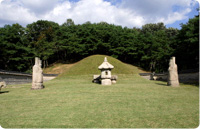
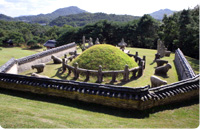
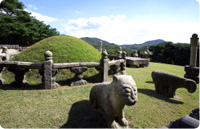
- Changneung Royal Tomb, Goyang (昌陵)
-
The tomb of King Yejong(睿宗, 1450~1469, r. 1468~1469), the 8th ruler of Joseon Dynasty, and his second consort Queen Ansun(安順王后, ?~1498).

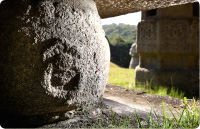
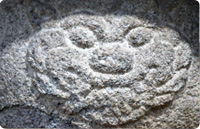
- Myeongneung Royal Tomb, Goyang (明陵)
-
The tomb of King Sukjong(肅宗, 1661~1720), the 19th ruler of Joseon Dynasty, and his second consort Queen Inhyeon(仁顯王后, 1667~1701), and his third consort Queen Inwon(仁元王后, 1687~1757).
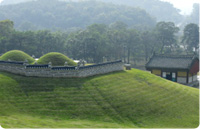
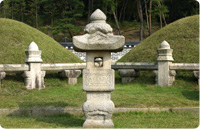

- Ingneung Royal Tomb, Goyang (翼陵)
-
The tomb of Queen Ingyeong(仁敬王后, 1661~1680), the royal first consort of King Sukjong(肅宗, r. 1674~1720), the 19th ruler of the Joseon Dynasty.
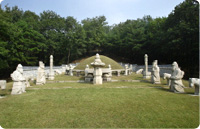

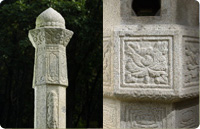
- Hongneung Royal Tomb, Goyang (弘陵)
-
The tomb of Queen Jeongseong(貞聖王后, 1692~1757), the royal first consort of King Yeongjo(英祖, r. 1724~1776), the 21th ruler of the Joseon Dynasty.
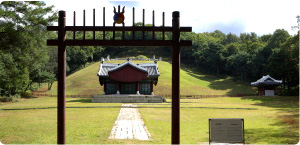
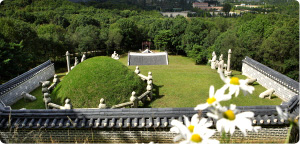
- Sunchangwon Royal Tomb, Goyang (順昌園)
-
 This is the royal tomb of the Crown Prince Sunhoe (順懷世子, 1551-1563) and his wife, the Crown Princess Gonghoebin (恭懷嬪, ?-1592), from the Yun family. The Crown
Prince Sunhoe was a son of the 13th King Myeongjong of the Joseon Dynasty. He was installed as Crown Prince at the age of seven. He had a proposal of marriage with
a daughter of Hwang Daeim. As she postponed the marriage for more than one year due to her poor health, the Crown Princess was replaced by a daughter of Yun Ok, and
the marriage was made in 1595. Not long after his marriage, the Crown Prince Sunhoe passed away at the age of 13 without an heir. Therefore, a grandson of King Jungjong,
Prince Haseong (King Seonjo), succeeded to the royal line following King Myeongjong. The Crown Princess Gonghoebin, from the Yun family, deceased in 1592 (the 25th year
of King Seonjo).
This is the royal tomb of the Crown Prince Sunhoe (順懷世子, 1551-1563) and his wife, the Crown Princess Gonghoebin (恭懷嬪, ?-1592), from the Yun family. The Crown
Prince Sunhoe was a son of the 13th King Myeongjong of the Joseon Dynasty. He was installed as Crown Prince at the age of seven. He had a proposal of marriage with
a daughter of Hwang Daeim. As she postponed the marriage for more than one year due to her poor health, the Crown Princess was replaced by a daughter of Yun Ok, and
the marriage was made in 1595. Not long after his marriage, the Crown Prince Sunhoe passed away at the age of 13 without an heir. Therefore, a grandson of King Jungjong,
Prince Haseong (King Seonjo), succeeded to the royal line following King Myeongjong. The Crown Princess Gonghoebin, from the Yun family, deceased in 1592 (the 25th year
of King Seonjo).
- Sugyeongwon Royal Tomb, Goyang (綏慶園)
-
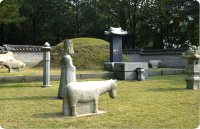 This is the tomb of the royal concubine Yeongbin (暎嬪, 1696-1764), from the Yi
family. She was a royal concubine of the 21st King Yeongjo of the Joseon Dynasty. She entered the palace at a young age and was installed as Yeongbin. She won great
favor of King Yeongjo. After having four princesses, she delivered the Crown Prince Sado in 1735, which made King Yeongjo very happy because he was waiting for an heir.
She did not lose her resolute attitude even under sad circumstances that the Crown Prince Sado was dethroned and killed in 1762. When she died in 1764 at the age of 69,
King Yeongjo felt very sad at her death and held a funeral with the best ceremony for the royal concubine. She was at first entombed in the Sugyeongwon, located in the
current Yonsei University. In 1970, her original tomb and the Hongsalmun (紅箭門 a red gate erected in honor of a loyal retainer) were moved to the current place. The
tomb is simple and so are stone figures in front of the mound.
This is the tomb of the royal concubine Yeongbin (暎嬪, 1696-1764), from the Yi
family. She was a royal concubine of the 21st King Yeongjo of the Joseon Dynasty. She entered the palace at a young age and was installed as Yeongbin. She won great
favor of King Yeongjo. After having four princesses, she delivered the Crown Prince Sado in 1735, which made King Yeongjo very happy because he was waiting for an heir.
She did not lose her resolute attitude even under sad circumstances that the Crown Prince Sado was dethroned and killed in 1762. When she died in 1764 at the age of 69,
King Yeongjo felt very sad at her death and held a funeral with the best ceremony for the royal concubine. She was at first entombed in the Sugyeongwon, located in the
current Yonsei University. In 1970, her original tomb and the Hongsalmun (紅箭門 a red gate erected in honor of a loyal retainer) were moved to the current place. The
tomb is simple and so are stone figures in front of the mound.
- Daebinmyo Royal Tomb, Goyang (大嬪墓)
-
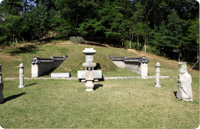 This is the royal tomb of Janghuibin, or Huibin (禧嬪, 1659-1701) from
the Jang family. She was a royal concubine of the 19th King Sukjong of the Joseon Dynasty and the mother of King Gyeongjong. Janghuibin entered the palace at a
young age as a court lady, and won King Sukjong’s favor. In 1686 (the 12th year of King Sukjong), she became Sugwon (淑媛, a rank given to a royal concubine),
and delivered Prince Yun (King Gyeongjong) in 1688. In the following year, when King Sukjong invested Prince Yun as a lawful son turning down an objection from
Song Siyeol and the Seoin (西人, a faction in the middle of Joseon), she was raised to be the 1st rank lady of a court, Huibin. In the same year, the Namin (南人,
a faction separated from the Dongin in the middle of Joseon) came into power with the Gisahwanguk (己巳換局) and Queen Inhyeon (仁顯王后. 1667~1701) was dethroned.
This is the royal tomb of Janghuibin, or Huibin (禧嬪, 1659-1701) from
the Jang family. She was a royal concubine of the 19th King Sukjong of the Joseon Dynasty and the mother of King Gyeongjong. Janghuibin entered the palace at a
young age as a court lady, and won King Sukjong’s favor. In 1686 (the 12th year of King Sukjong), she became Sugwon (淑媛, a rank given to a royal concubine),
and delivered Prince Yun (King Gyeongjong) in 1688. In the following year, when King Sukjong invested Prince Yun as a lawful son turning down an objection from
Song Siyeol and the Seoin (西人, a faction in the middle of Joseon), she was raised to be the 1st rank lady of a court, Huibin. In the same year, the Namin (南人,
a faction separated from the Dongin in the middle of Joseon) came into power with the Gisahwanguk (己巳換局) and Queen Inhyeon (仁顯王后. 1667~1701) was dethroned.When Prince Yun was invested as the Crown Prince, she was installed as Queen. In 1694, the Namin rose in rebellion with the restoration movement of Queen Inhyeon by the Seoin as a momentum. However, King Sukjong eliminated the Namin and made the Seoin return to power again (甲戌換局, the Gapsulhwanguk). With the restoration of Queen Inhyeon, she was demoted to Huibin. When the Queen Inhyeon died of a disease in 1701, she was impeached by the Seoin for the crime of falsely accusing Queen Inheyon and received poison as a death penalty. Since then, King Sukjong prohibited elevating the Bin (嬪, Royal Concubine) to the Bi (妃, Queen) by law. She was originally entombed in Munhyeong-ri Opo-myeon Gwangju-gun Gyeonggi-do. Her tomb was moved to its current place in 1969.



 >
>